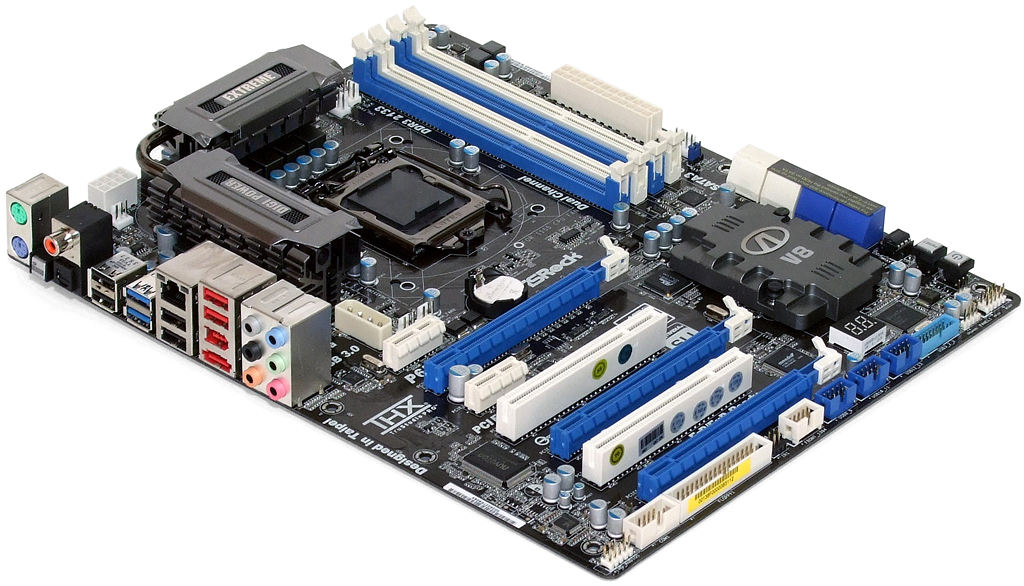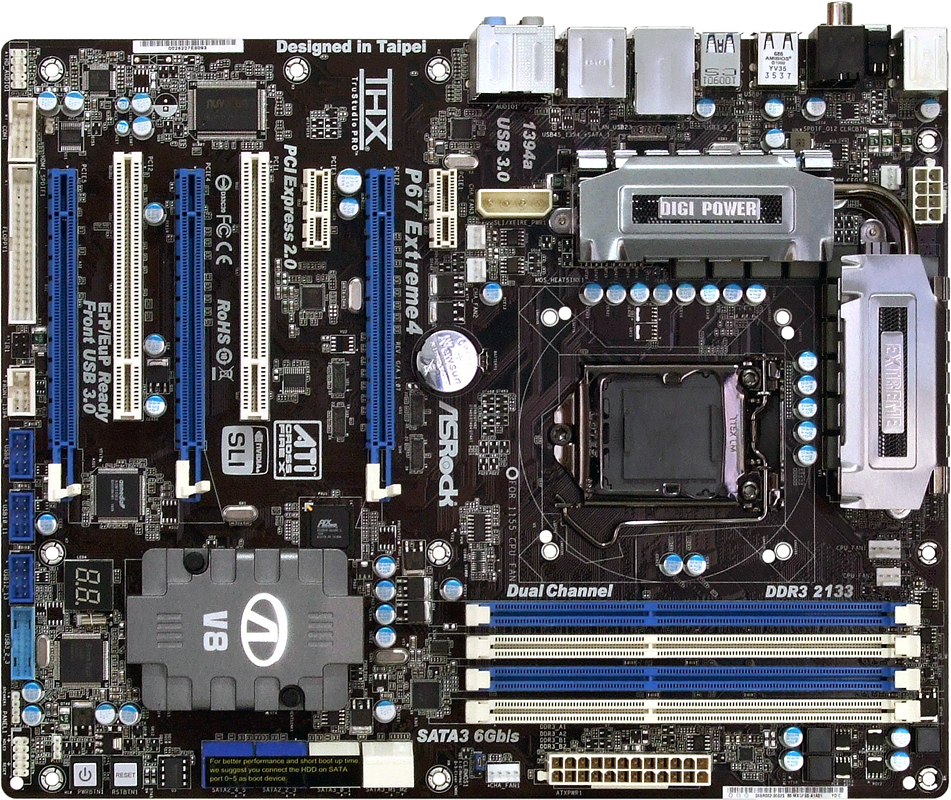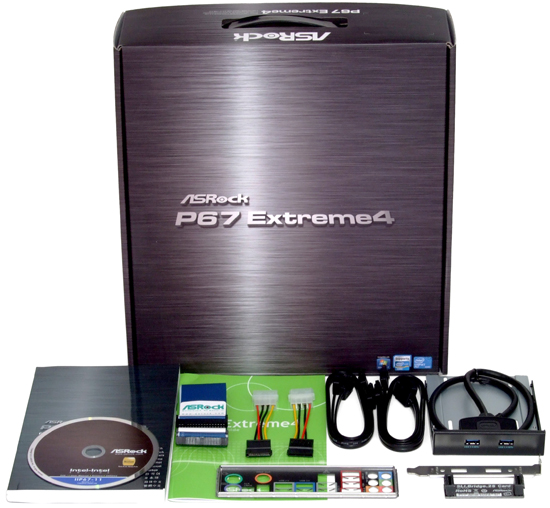P67 Motherboard Roundup: Nine $150-200 Boards
Improved per-clock performance and higher achievable frequencies are sure to put Intel’s latest K-Series CPUs on top of many builders’ whish lists, but they’ll still need a new socket to put it in. We test nine enthusiast-oriented LGA-1155 motherboards.
ASRock P67 Extreme4
Always striving for the best apparent value, ASRock loads its P67 Extreme4 with three PCIe x16-length slots and four SATA 6Gb/s ports, plus dual USB 3.0 controllers to address both front and rear panel needs.
Yet, the extra features aren’t completely without at least some minor compromise. The third graphics card slot, for example, is limited to four pathways, while the other two switch from single x16 to dual x8 connections whenever a card is added to the middle slot. An eSATA port is also shared with one of the added SATA 6Gb/s ports, so that builders must decide whether or not to sacrifice eSATA for the sake of an extra internal drive.
A PLX controller keeps onboard PCIe devices operating near full performance levels, while an ASM1083 bridge adds PCI support.
ASRock knows that Windows XP hasn’t been completely abandoned by the gaming market yet, and those few holdouts can get AHCI support during OS installation thanks to an included floppy port. That port comes free via the Multi-I/O controller, while the added-cost Ultra ATA connector is instead removed. We suggested this move a few years ago when Vista’s performance problems made the elder OS desirable, but Windows 7’s improvements have significantly reduced the XP market. The presence of this connector in such an unobtrusive location doesn’t bother us, and the pin cost is insignificant.
There’s very little in the entire P67 Extreme4’s layout that we could criticize, though the bottom-rear-corner front-panel audio connector is still inconvenient for the connections of some cases. More worrisome for those considering a triple-card CrossFireX configuration is that every front-panel cable end will block the insertion of most performance-oriented graphics cards. Determined builders can usually force the card to the bottom by using the side of its cooler to smash front-panel cable ends flat, but we’d rather not tempt fate.
ASRock was the first to respond to our industry-wide pleas for a “universal” front-panel USB 3.0 port, and had already taken us up on the suggestion to include both drive bay and slot panel brackets. The company has further improved the P67 Extreme4’s installation kit by adding a 2.5” drive tray to its front-panel bay adapter.
Get Tom's Hardware's best news and in-depth reviews, straight to your inbox.
Current page: ASRock P67 Extreme4
Prev Page The Future Of Mid-Priced Performance Next Page P67 Extreme4 UEFI-
reprotected I thought that the ECS looked pretty sick, and it did perform alright. But unfortunately, it wasn't the best.Reply -
rantsky You guys rock! Thanks for the review!Reply
I'm just missing benchmarks like SATA/USB speeds etc. Please Tom's get those numbers for us! -
rmse17 Thanks for the prompt review of the boards! I would like to see any differences in quality of audio and networking components. For example, what chipsets are used for Audio in each board, how that affects sound quality. Same thing for network, which chipset is used for networking, and bandwidth benchmarks. If you guys make part 2 to the review, it would be nice to see those features, as I think that would be one more way these boards would differentiate themselves.Reply -
VVV850 Would have been good to know the bios version for the tested motherboards. Sorry if I double posted.Reply -
flabbergasted I'm going for the ASrock because I can use my socket 775 aftermarket cooler with it.Reply -
stasdm Do not see any board worth spending money on.Reply
1. SLI "support". Do not understand why end-user has to pay for mythical SLI "sertification" (all latest Intel chips support SLI by definition) and a SLI bridge coming with the board (at least 75% of end users would never need one). The bridge should come with NVIDIA cards (same as with AMD ones). Also, in x8/x8 PCIe configuration nearly all NVIDIA cards (exept for low-end ones) will loose at least 12% productivity - with top cards that is about $100 spent for nothing (AMD cards would not see that difference). So, If those cards are coming as SLI-"sertified" they have to be, in the worst case, equipped by NVIDIA NF200 chip (though, I would not recommend to by cards with this PCIe v.1.1 bridge). As even NVIDIA GF110 cards really need less than 1GB/s bandwidth (all other NVIDIA and AMD - less than 0.8GB/s)and secondary cards in SLI/CrossFire use no more than 1/4 of that, a normal PCIe v.2.0 switch (costing less than thrown away with x8/x8 SLI money) will nicely support three "Graphics only" x16 slots, fully-functional x8 slot and will provide bandwidth enough to support one PCIe v.2.0 x4 (or 4 x x1) slot(s)/device(s).
2. Do not understand the author euphoria of mass use of Marvell "SATA 6G" chips. The PCIe x1 chip might not be "SATA 6G" by definision, as it woud newer be able to provide more than 470GB/s (which is far from the standard 600GB/s) - so, I'd recommend to denote tham as 3G+ or 6G-. As it is shown in the upper section, there is enough bandwidth for real 6G solution (PCIe x8 LSISAS 2008 or x4 LSISAS 2004). Yes, will be a bit more expensive, but do not see the reason to have a palliative solutions on $200+ mobos.
-
I was hoping that the new Asus Sabertooth P67 would be included. Its new design really is leaving people wondering if the change is as good as they claim.Reply



